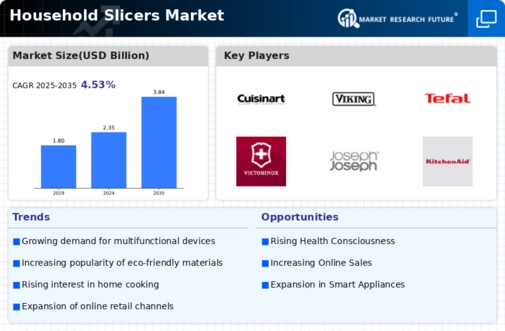Market Growth Projections
The Global Household Slicers Market Industry is poised for substantial growth, with projections indicating a market value of 2.35 USD Billion in 2024 and an anticipated increase to 3.84 USD Billion by 2035. This growth trajectory suggests a compound annual growth rate of 4.56% from 2025 to 2035. Such figures reflect the increasing consumer interest in kitchen appliances that enhance cooking efficiency and convenience. As the market evolves, it is likely to witness the introduction of innovative products that cater to diverse consumer needs, further driving its expansion.
Health and Wellness Trends
Health and wellness trends are reshaping consumer preferences, thereby impacting the Global Household Slicers Market Industry. With an increasing focus on nutritious diets, consumers are more inclined to purchase fresh produce and prepare meals at home. Slicers enable users to create healthy dishes with ease, promoting the consumption of fruits and vegetables. This shift towards healthier eating habits is likely to drive market growth, as individuals seek tools that support their dietary goals. The industry's response to this trend may further enhance its appeal, contributing to the anticipated market expansion over the coming years.
Rising Demand for Home Cooking
The Global Household Slicers Market Industry experiences a notable surge in demand as more consumers embrace home cooking. This trend is driven by a growing awareness of healthy eating and the desire for fresh ingredients. As individuals seek to replicate restaurant-quality meals at home, the need for efficient kitchen tools, such as slicers, becomes apparent. In 2024, the market is projected to reach 2.35 USD Billion, reflecting the increasing preference for home-prepared meals. This inclination towards culinary creativity suggests a sustained growth trajectory for the industry, potentially leading to a compound annual growth rate of 4.56% from 2025 to 2035.
Expansion of E-commerce Platforms
The expansion of e-commerce platforms significantly influences the Global Household Slicers Market Industry. As online shopping becomes more prevalent, consumers are increasingly turning to digital channels to purchase kitchen appliances, including slicers. E-commerce offers convenience, a wider selection, and often competitive pricing, making it an attractive option for consumers. This shift in purchasing behavior is expected to bolster market growth, as online retailers provide access to various brands and models. The ongoing evolution of e-commerce is likely to play a crucial role in shaping the future landscape of the household slicers market.
Growing Popularity of Meal Prep Culture
The meal prep culture is gaining traction globally, significantly influencing the Global Household Slicers Market Industry. As individuals increasingly adopt meal prepping as a lifestyle choice, the need for versatile kitchen tools becomes essential. Slicers facilitate the preparation of ingredients in bulk, allowing consumers to save time and maintain portion control. This trend is particularly evident among busy professionals and health-conscious individuals who seek to streamline their cooking processes. The market's growth is indicative of this shift, with projections suggesting a steady increase in demand as more consumers recognize the benefits of meal prepping.
Technological Advancements in Kitchen Appliances
Technological innovations play a pivotal role in shaping the Global Household Slicers Market Industry. Manufacturers are increasingly integrating advanced features into slicers, such as adjustable thickness settings, safety mechanisms, and easy-to-clean designs. These enhancements not only improve user experience but also cater to the evolving needs of consumers who prioritize convenience and efficiency. As a result, the market is likely to witness an influx of high-tech slicers that appeal to tech-savvy home cooks. This trend aligns with the projected growth of the market, which is expected to reach 3.84 USD Billion by 2035, indicating a robust demand for innovative kitchen solutions.













